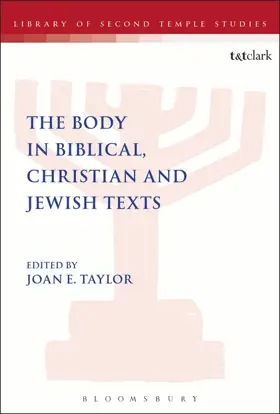

The Body in Biblical, Christian and Jewish Texts
in Library of Second Temple Studies
Pages
304
Publisher
T&T Clark
Published
12/17/2015
ISBN-13
9780567666079
The body is an entity on which religious ideology is printed. Thus it is frequently a subject of interest, anxiety, prescription and regulation in both the Hebrew Bible and the New Testament, as well as in early Christian and Jewish writings. Issues such as the body's age, purity, sickness, ability, gender, sexual actions, marking, clothing, modesty or placement can revolve around what the body is and is not supposed to be or do.
The Body in Biblical, Christian and Jewish Texts comprises a range of inter-disciplinary and creative explorations of the body as it is described and defined in religious literature, with chapters largely written by new scholars with fresh perspectives. This is a subject with wide and important repercussions in diverse cultural contexts today.
The Body in Biblical, Christian and Jewish Texts comprises a range of inter-disciplinary and creative explorations of the body as it is described and defined in religious literature, with chapters largely written by new scholars with fresh perspectives. This is a subject with wide and important repercussions in diverse cultural contexts today.
- Contents
- List of Figures
- List of Abbreviations
- Notes on Contributors
- Introduction - Joan E. Taylor, King's College London, UK
- 1: The Body Inscribed: A Priestly Initiative - Sandra Jacobs, King's College London, UK
- 2: Queering the Body: Un-desiring Sex in Leviticus - Steffan Mathias, King's College London, UK
- 3. Ritualized Bodies in the Valley of Dry Bones (Ezek 37.1-14) - Casey Strine, University of Sheffield, UK
- 4. 'Two by two': The Ark-etypal Language of Mark's Apostolic Pairings - Joan Taylor, King's College London, UK
- 5. Jesus' Gentile healings: The Absence of Physical Contact and the Requirement of Faith - Rebecca Harrocks, King's College London, UK
- 6. 'This is my Body': Jewish Blessing or Thyestean Banquet? - Katie Turner, King's College London, UK
- 7. How are the Dead Raised? The Resurrection of the Dead as a Bodily Phenomenon in Second Temple Jewish Writings - Daniel Hayter, King's College London, UK
- 8. Flesh for Franken-whore: Reading Babylon's Body in Revelation 17 - Michelle Fletcher, King's College London, UK
- 9. Can a Body Change? Josephus' Attitude to Circumcision and Conversion - Davina Grojnowski, King's College London, UK
- 10. The Acts of Paul and Thecla: Violating the Inviolate Body – Thecla Uncut - Rosie Ratcliffe, King's College London, UK
- 11. The Fire and the Flesh: Self-Destruction of the Male Rabbinic Body - Laliv Clenman, King's College London, UK
- Bibliography
- Index
Inner Books
This physical volume has several internal sections, each of which has been reviewed independently
- The Body Inscribed: A Priestly Initiative by Sandra Jacobs
- Queering the Body: Un-desiring Sex in Leviticus by Steffan Mathias
- Ritualized Bodies in the Valley of Dry Bones (Ezek 37.1-14) by Casey Strine
- 'Two by two': The Ark-etypal Language of Mark's Apostolic Pairings by Joan E. Taylor
- Jesus' Gentile healings: The Absence of Physical Contact and the Requirement of Faith by Rebecca Harrocks
- 'This is my Body': Jewish Blessing or Thyestean Banquet? by Katie Turner
- How are the Dead Raised? The Resurrection of the Dead as a Bodily Phenomenon in Second Temple Jewish Writings by Daniel Hayter
- Flesh for Franken-whore: Reading Babylon's Body in Revelation 17 by Michelle Fletcher
- Can a Body Change? Josephus' Attitude to Circumcision and Conversion by Davina Grojnowski
- The Acts of Paul and Thecla: Violating the Inviolate Body by Thecla Uncut
- The Fire and the Flesh: Self-Destruction of the Male Rabbinic Body by Laliv Clenman